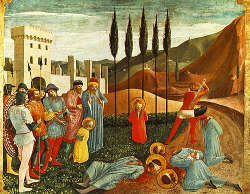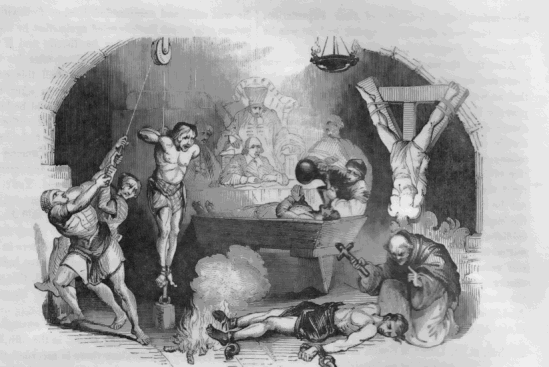Servant of God - Ignatius de Velasco, SJ & 6 Companions
Born: 4 October 1542
Died: 17 September 1621
Beatified 13 May 1923, Rome by Pope Pius XI
Canonized 29 June 1930, Rome by Pope Pius XI
 Fr Ignatius de Velasco y Nieto and his 6 companions, Frs Ballesta Tejero, John Gomez Hellin, Joseph Alegre Jimenez, Emmanuel de la Cerda y de las Barcenas, Brs. Ignatius Elduayen y Larranaga, and Pascual Ruiz Ramirez, were martyred by communist revolutionary forces between August 7 and December 4, 1936 in Madrid during the Spanish Civil War.
Fr Ignatius de Velasco y Nieto and his 6 companions, Frs Ballesta Tejero, John Gomez Hellin, Joseph Alegre Jimenez, Emmanuel de la Cerda y de las Barcenas, Brs. Ignatius Elduayen y Larranaga, and Pascual Ruiz Ramirez, were martyred by communist revolutionary forces between August 7 and December 4, 1936 in Madrid during the Spanish Civil War.
Fr Velasco was born at Las Arenas in the Spanish province of Vizcaya and studied to be a mining engineer. He came to know Fr Joseph Mary Rubio while living in Madrid and frequently accompanied him on his visits to the poor. It was through this association with Fr Rubio that led the young Velasco to the Society of Jesus and eventually to leave school and enter the novitiate. He did not stay long and had to return home as his father was in poor health. He completed his studies in engineering and returned to the novitiate again at Granada , on November 12, 1917. After his noviceship, he did classical studies from 1920 to 1922 before spending four years doing his philosophy. After teaching mathematics for about two years at Chamartin College in Madrid, he finally did theology at Ona. Ignatius found the theology course somewhat difficult as he was older than his fellow Jesuits and had a poor memory. He thought of becoming a brother but through perseverance in studies he passed his examinations and was ordained in 1930. After he finished his theology in 1931, Fr Velasco went to Portugal for his tertianship. However the Society was suppressed in Spain in early 1932 so Fr Velasco taught mathematics at the Jesuit school in Liege, Belgium, for two years.
As a priest, Fr Velasco’s interests were no longer engineering or mathematics but the poor that attracted him. He remembered the great number of them in Madrid who lived in misery and without sufficient food. He thus sought his superior’s approval to allow him to continue the apostolate begun by Fr Rubio many years earlier. Permission was granted and Fr Velasco left Belgium in 1934 to return to Madrid to help the less fortunate. He lived as poorly as they did and never had a peseta in his pocket. His apostolate was however terminated in July 1936 because of the outbreak of war between Spain’s communist and nationalist movements.
With the country in civil war, priests were vigorously hunted by communist revolutionaries. When the Jesuit community had to be dispersed, Fr Velasco went to live with his sister. When one of their cousins was jailed, his sister who visited him on September 20 narrated that the prisoners were all very contented in prison as the priests there were allowed to celebrate Mass daily and everyone had the opportunity to receive Holy Communion. Their cousin compared it to being in the catacombs during early Christian times. Fr Velasco’s spirit brightened and he remarked that he would not mind being in prison, for there he could do much good for others. He also added: “And if they kill me, so much the better. I will go straight to heaven without passing through purgatory.” At this statement his mother began to cry. He turned to her saying: “Don’t cry, mother. If they kill me as a priest, as a Jesuit; I will be a martyr and I will go to heaven. I became a Jesuit in order to die for Christ. For this I left you and my career. So don’t cry,”
Fr Velasco’s desire was soon fulfilled. The next day, September 21, at 10.00 am, several militiamen came to the house and took the entire family to their station. They told them that they were looking for a certain individual and as soon as they found him the others would be set free. After separating the men and women, they interrogated them. When Fr Velesco was interrogated, knowing well that he was the main object of their search, he openly admitted that he was a Jesuit priest. They then asked him why his identification card described him as an engineer and he simple said that he was also an engineer.
On September 23 at around 11.45 am, two days after he was detained, a rough voice shouted into the room where the men were kept, “Ignatius de Velasco.” Everyone knew what that meant. The priest gave a goodbye embrace to everyone and left with the soldiers. Fr Velasco was taken to the road that led to Andalusia and there the forty-six year old priest was martyred at about 1.00 am, September 24, 1936. That same day his body was identified and buried.
 His 6 Jesuit companions were:
His 6 Jesuit companions were:
Br Ignatius Elduayen y Larranaga, born on March 9, 1884 at Azcoitia, in to Madrid in 1917 to work at Charmartin College before being assigned to the Gregorian University in Rome. He returned to Madrid in 1935 and lived at the Christopher Columbus Academy (the former Charmatin College)and was in charge of the lay workers.
Br Pascual Ruiz Ramirez, born on February 14, 1901, in Cuidad Real and entered The Society in Granada on June 14, 1917. He was a tailor at the Granada Scholasticate for three years and then spent seven years at the College of St Callistus in La Paz, Bolivia. After his return to Madrid he too was stationed at the academy.
Both Brs Elduayen and Ruiz died by gunshots at the hands of the revolutionaries on August 7, 1936. Br Elduayen was fifty-two years old and Br Ruiz thirty-five.
Fr Jesus Ballesta Tejero, born on January 1, 1903 at Vera da Moncayo in the province of Saragossa . He entered the Jesuit novitiate at Veruela on January 5, 1918. Studied philosophy and theology at Sarria near Barcelona and was ordained in 1932. He was particularly interested in workers’ movements and was very involved in the Labour Institute in Madrid. He continued in his ministry even when the revolution broke out until he was betrayed by a worker. Fr Ballesta was thirty-three years old when he was martyred.
Fr John Gomez Hellin, born in Alguazas in Murcia province on September 15, 1899. He entered the novitiate at Granada on June 14, 1917. After his philosophy he taught history and Spanish at the College of the Sacred Heart in Sucre, Bolivia. After his theology in Spain he was ordained in 1929. When civil war broke out, Fr Gomez was taken away by the communists and when he admitted he was a Jesuit he was martyred on October 2, 1936.
Fr Joseph Alegre Jimenez, born at Cartagena in Murcia province on November 1, 1865. He entered the Society on October 7, 1865 and spent most of his priestly life at Charmartin College in Madrid. As he was seventy-five at the time of his arrest, the communists told him to go home and stay out of trouble. Three months later, Fr Alegre was arrested and in retaliation to the nationalist movement’s heavy bombardment of Madrid, Fr Alegre was martyrd for being a Jesuit on November 9, 1936.
Fr Emmanuel de la Cerda y las Barcenas, born in Madrid on December 5, 1900. He entered the novitiate at Granada on October 6, 1926. He was especially interested in natural history and spent three years in La Paz, Bolivia in that field. After his theology in Ona he was ordained in 1931. When civil war broke out Fr Cerda was in Madrid. He went to stay with his parents. Listed as a student on his identity card, he continued to go about the city administering his priestly ministry. He was unexpectedly apprehended in mid-September 1936 after visiting someone who was dying. Even in prison he continued to preach, teach catechism and hear confessions. On Dec 4, when his name was called out, Fr Cerda went to the other priest in the cell and asked for absolution. After embracing everyone he was taken by his jailers to be executed.
The cause of Fr Velasco and his 6 Jesuit companions was opened in Madrid on September 28, 1945 .
